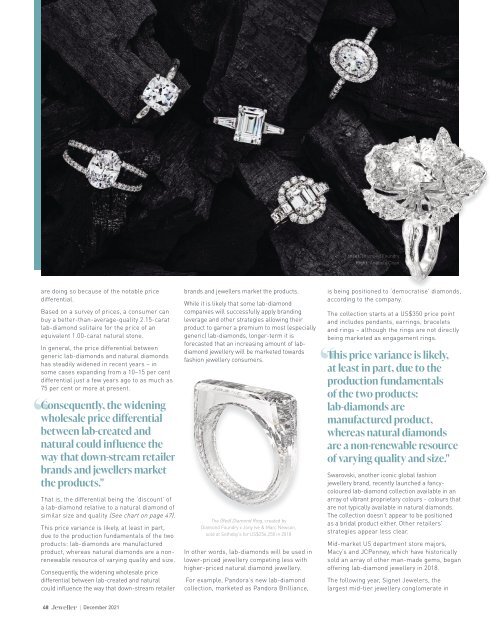Jeweller - December 2021
• Created increase: lab-created diamond sales forecast to double by 2025 • Golden touch: is it true that rising gold price decreases jewellery sales? • Risky customers: identify and remedy your 'at-risk' customers
• Created increase: lab-created diamond sales forecast to double by 2025
• Golden touch: is it true that rising gold price decreases jewellery sales?
• Risky customers: identify and remedy your 'at-risk' customers
Create successful ePaper yourself
Turn your PDF publications into a flip-book with our unique Google optimized e-Paper software.
Inset: Diamond Foundry<br />
Right: Anabela Chan<br />
are doing so because of the notable price<br />
differential.<br />
Based on a survey of prices, a consumer can<br />
buy a better-than-average-quality 2.15-carat<br />
lab-diamond solitaire for the price of an<br />
equivalent 1.00-carat natural stone.<br />
In general, the price differential between<br />
generic lab-diamonds and natural diamonds<br />
has steadily widened in recent years – in<br />
some cases expanding from a 10–15 per cent<br />
differential just a few years ago to as much as<br />
75 per cent or more at present.<br />
Consequently, the widening<br />
wholesale price differential<br />
between lab-created and<br />
natural could influence the<br />
way that down-stream retailer<br />
brands and jewellers market<br />
the products."<br />
That is, the differential being the ‘discount’ of<br />
a lab-diamond relative to a natural diamond of<br />
similar size and quality (See chart on page 47).<br />
This price variance is likely, at least in part,<br />
due to the production fundamentals of the two<br />
products: lab-diamonds are manufactured<br />
product, whereas natural diamonds are a nonrenewable<br />
resource of varying quality and size.<br />
Consequently, the widening wholesale price<br />
differential between lab-created and natural<br />
could influence the way that down-stream retailer<br />
brands and jewellers market the products.<br />
While it is likely that some lab-diamond<br />
companies will successfully apply branding<br />
leverage and other strategies allowing their<br />
product to garner a premium to most (especially<br />
generic) lab-diamonds, longer-term it is<br />
forecasted that an increasing amount of labdiamond<br />
jewellery will be marketed towards<br />
fashion jewellery consumers.<br />
The (Red) Diamond Ring, created by<br />
Diamond Foundry x Jony Ive & Marc Newson,<br />
sold at Sotheby's for US$256,250 in 2018<br />
In other words, lab-diamonds will be used in<br />
lower-priced jewellery competing less with<br />
higher-priced natural diamond jewellery.<br />
For example, Pandora’s new lab-diamond<br />
collection, marketed as Pandora Brilliance,<br />
is being positioned to ‘democratise’ diamonds,<br />
according to the company.<br />
The collection starts at a US$350 price point<br />
and includes pendants, earrings, bracelets<br />
and rings – although the rings are not directly<br />
being marketed as engagement rings.<br />
This price variance is likely,<br />
at least in part, due to the<br />
production fundamentals<br />
of the two products:<br />
lab-diamonds are<br />
manufactured product,<br />
whereas natural diamonds<br />
are a non-renewable resource<br />
of varying quality and size."<br />
Swarovski, another iconic global fashion<br />
jewellery brand, recently launched a fancycoloured<br />
lab-diamond collection available in an<br />
array of vibrant proprietary colours - colours that<br />
are not typically available in natural diamonds.<br />
The collection doesn’t appear to be positioned<br />
as a bridal product either. Other retailers'<br />
strategies appear less clear.<br />
Mid-market US department store majors,<br />
Macy’s and JCPenney, which have historically<br />
sold an array of other man-made gems, began<br />
offering lab-diamond jewellery in 2018.<br />
The following year, Signet Jewelers, the<br />
largest mid-tier jewellery conglomerate in<br />
48 | <strong>December</strong> <strong>2021</strong>


















